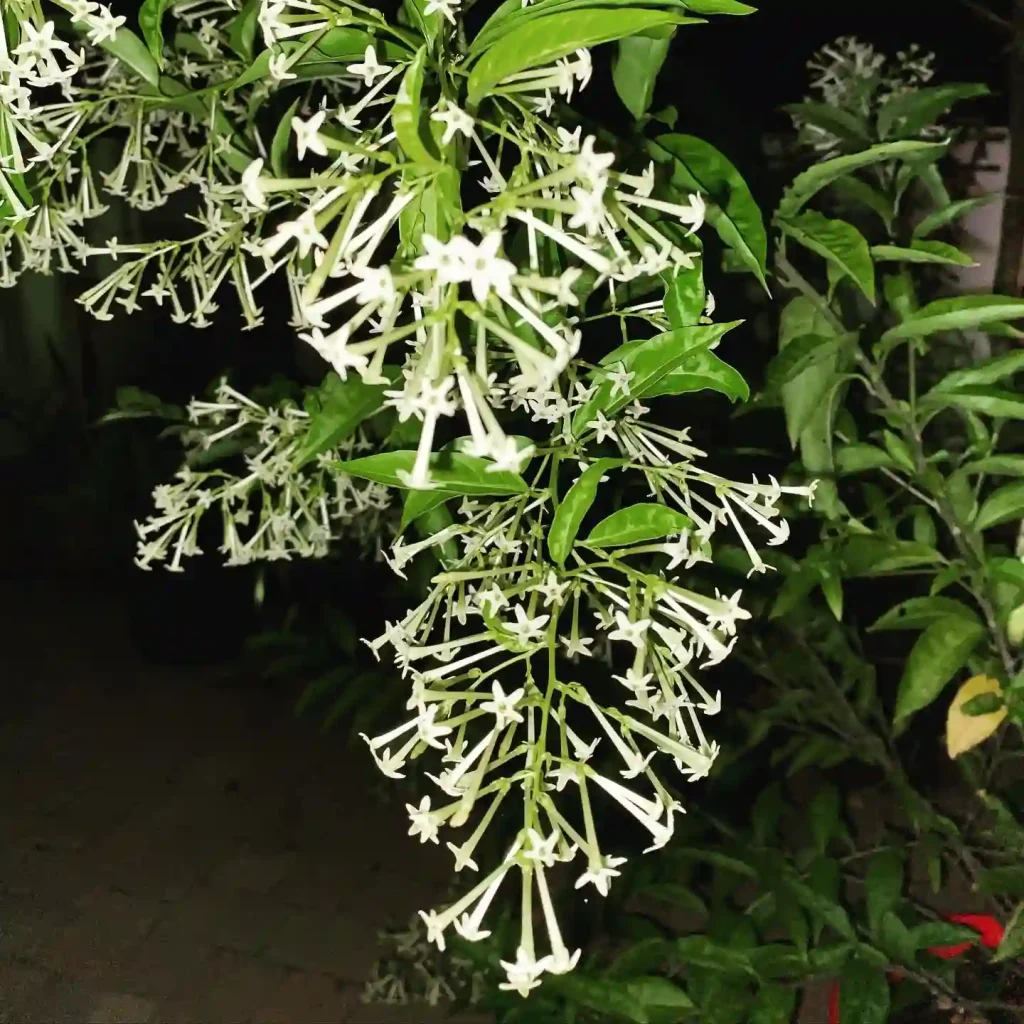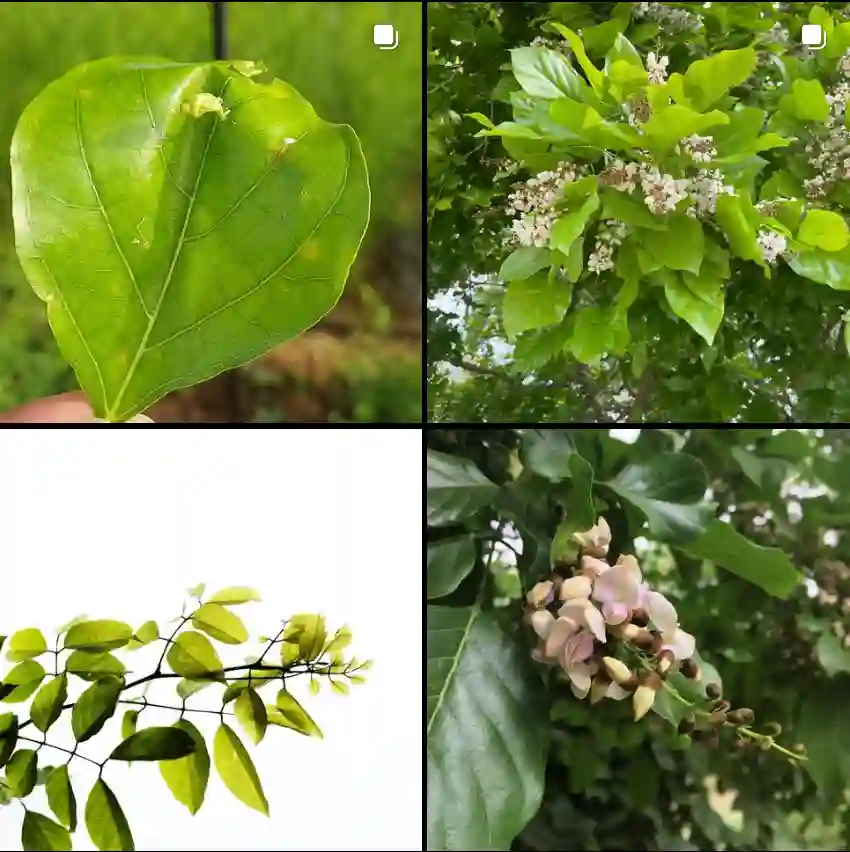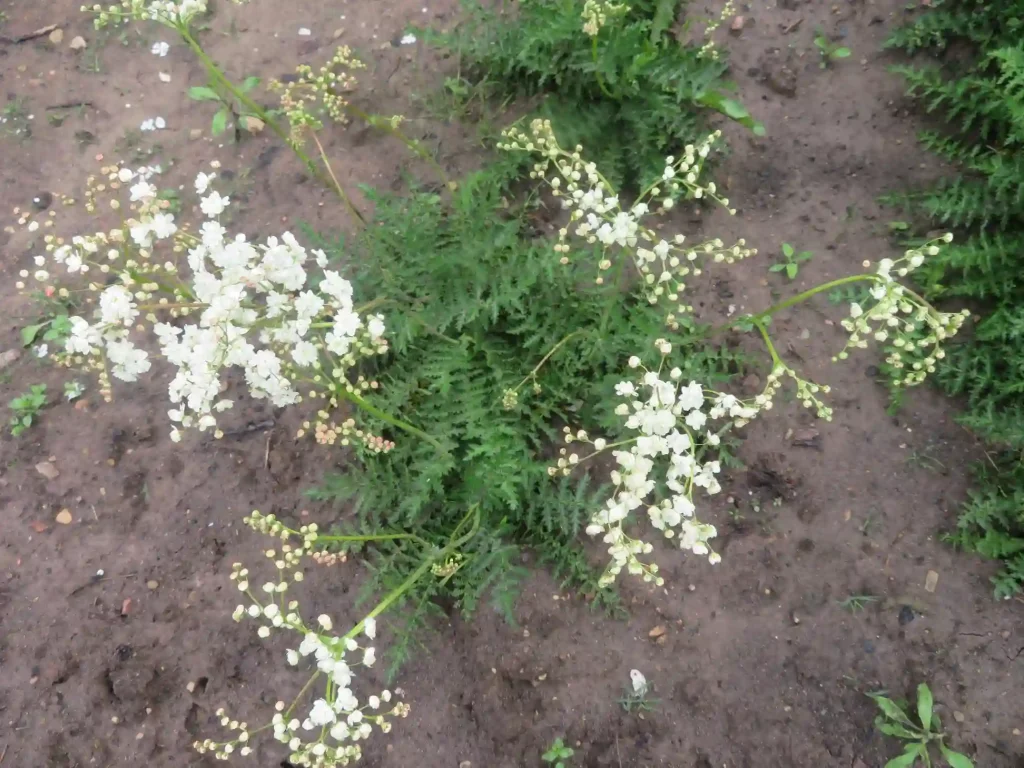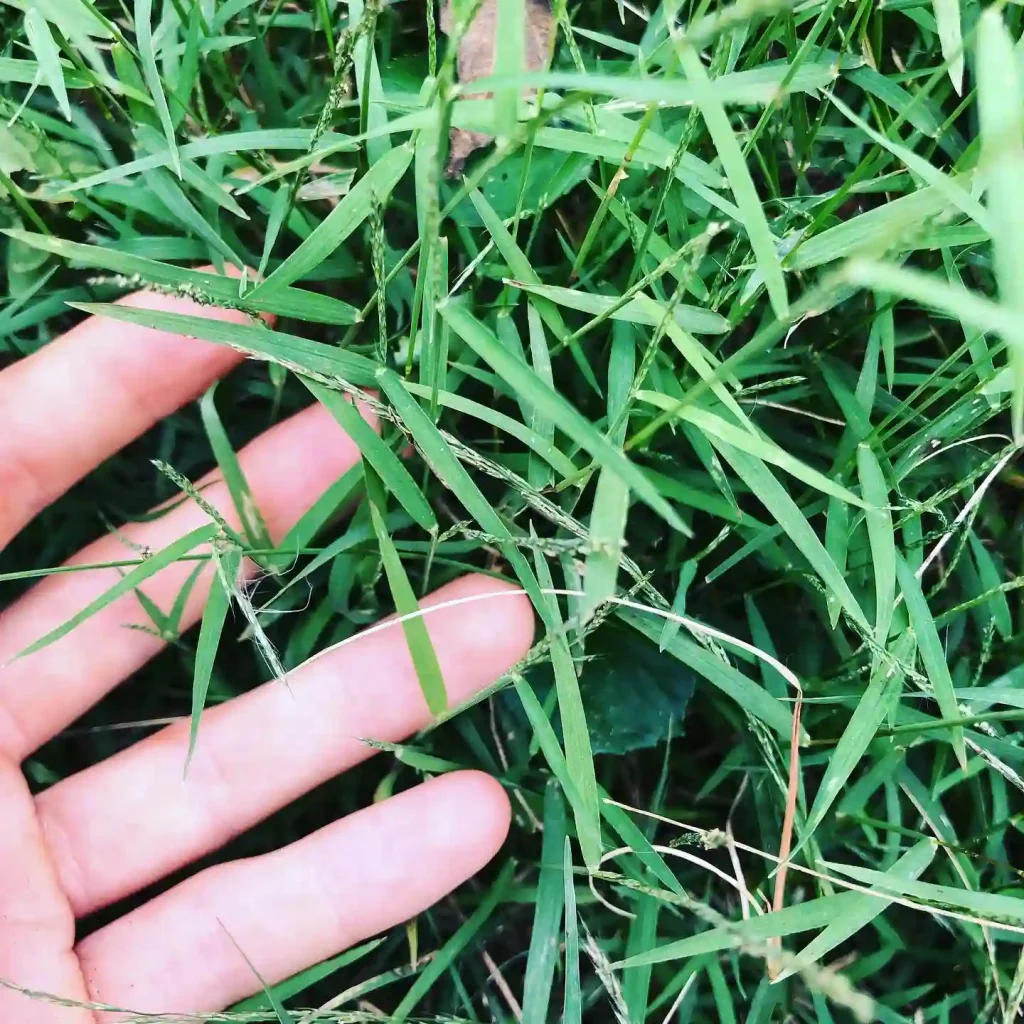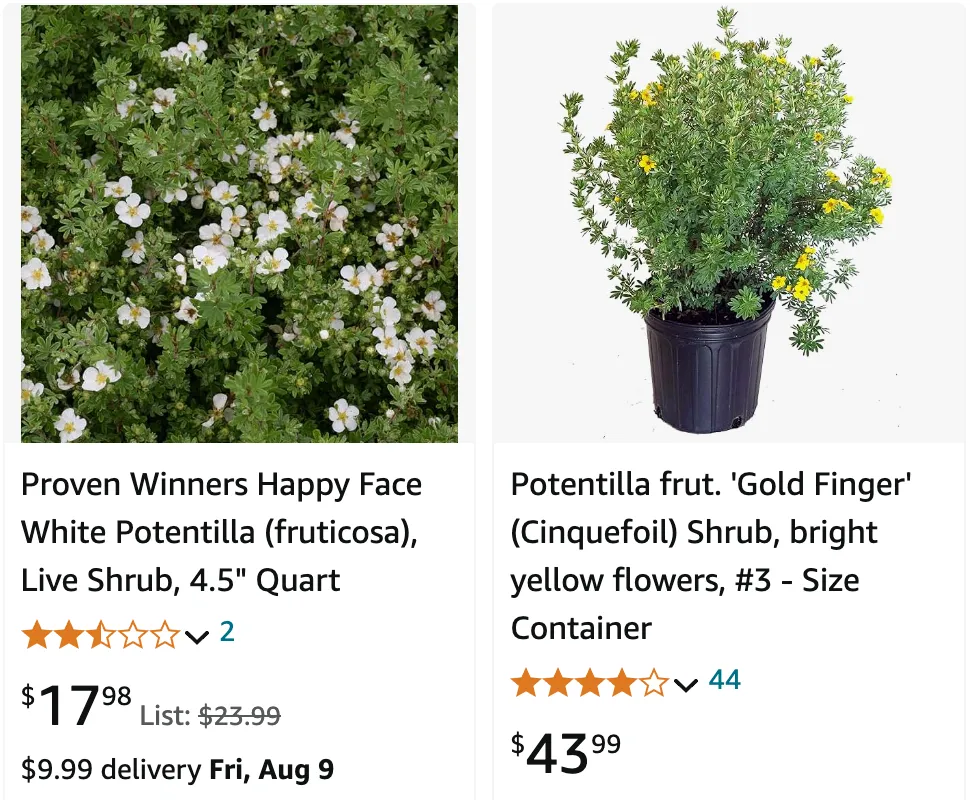
What is Potentilla?
Potentilla, also known as Cinquefoil, is a versatile and hardy plant that belongs to the Rosaceae family. It includes a variety of species, both herbaceous and shrubby, that are prized for their bright and cheerful flowers. These plants are native to the Northern Hemisphere and are commonly found in gardens for their ease of care and long blooming periods.
Potentilla species
- Potentilla acaulis L.
- Potentilla adenotricha Vodop.
- Potentilla adriatica Murb.
- Potentilla agrimonioides M.Bieb.
- Potentilla × ala-arczae Soják
- Potentilla alba L.
- Potentilla albiflora L.O.Williams
- Potentilla alborzensis Faghir & Attar
- Potentilla alchimilloides Lapeyr.
- Potentilla algida Soják
- Potentilla alpicola De la Soie
- Potentilla alsatica T.Gregor
- Potentilla altaica Bunge
- Potentilla ambigens Greene
- Potentilla amicarum Ertter
- Potentilla anachoretica Soják
- Potentilla anadryensis Juz.
- Potentilla anatolica Peșmen
- Potentilla ancistrifolia Bunge
- Potentilla anemonifolia Lehm.
- Potentilla angelliae N.H.Holmgren
- Potentilla anglica Laichard.
- Potentilla angustiloba T.T.Yu & C.L.Li
- Potentilla apennina Ten.
- Potentilla aperta J.T.Howell
- Potentilla approximata Bunge
- Potentilla arcadiensis Iatroú
- Potentilla arctica Rouy
- Potentilla arenosa (Turcz.) Juz.
- Potentilla argaea Boiss. & Balansa
- Potentilla argentea L.
- Potentilla argenteiformis Kauffm.
- Potentilla argyrocoma (Rydb.) Jeps.
- Potentilla argyroloma Boiss. & Hohen.
- Potentilla argyrophylla Wall. ex Lehm.
- Potentilla arizonica Greene
- Potentilla articulata Franch.
- Potentilla asiae-mediae Ovcz. & Kochk.
- Potentilla asiatica (Th.Wolf) Juz.
- Potentilla asinaria Maire
- Potentilla aspegrenii Kurtto
- Potentilla asperrima Turcz.
- Potentilla assalemica Soják
- Potentilla asterotricha Soják
- Potentilla astracanica Jacq.
- Potentilla astragalifolia Bunge
- Potentilla asturica Rothm.
- Potentilla atrosanguinea G.Lodd.
- Potentilla aucheriana Th.Wolf ex Bornm.
- Potentilla × aurantiaca Soják
- Potentilla aurea L.
- Potentilla bactriana Soják
- Potentilla baekdusanensis M.Kim
- Potentilla baileyi (S.Watson) Greene
- Potentilla balansae Peșmen
- Potentilla bannehalensis Cambess.
- Potentilla basaltica Tiehm & Ertter
- Potentilla × beckii Murr
- Potentilla beringensis Jurtzev
- Potentilla beringii Jurtzev
- Potentilla betonicifolia Poir.
- Potentilla bhutanica Ludlow
- Potentilla bicrenata Rydb.
- Potentilla biennis Greene
- Potentilla biflora D.F.K.Schltdl.
- Potentilla bimundorum Soják
- Potentilla bipinnatifida Douglas ex Hook.
- Potentilla × bishkekensis Soják
- Potentilla × blanda Soják
- Potentilla bolanderi (A.Gray) Greene
- Potentilla × boreocaucasica Kechaykin
- Potentilla bornmuelleri Borbás
- Potentilla botschantzeviana Adylov
- Potentilla brachypetala Fisch. & C.A.Mey. ex Lehm.
- Potentilla brauneana (DC.) Hoppe ex Nestl.
- Potentilla brevifolia Nutt.
- Potentilla brevifoliolata P.D.Sell
- Potentilla breweri S.Watson
- Potentilla bruceae Rydb.
- Potentilla bryoides Soják
- Potentilla buccoana Clementi
- Potentilla bungei Boiss.
- Potentilla × burjatica Soják
- Potentilla butkovii Botsch.
- Potentilla calabra Ten.
- Potentilla californica (Cham. & Schltdl.) Greene
- Potentilla caliginosa Soják
- Potentilla callida H.M.Hall
- Potentilla camillae Kolak.
- Potentilla campestris (M.E.Jones) Jeps.
- Potentilla canadensis L. Plant FAQs: Potentilla Canadensis – Dwarf Cinquefoil – Running Cinquefoil
- Potentilla candicans Humb. & Bonpl. ex Nestl.
- Potentilla cappadocica Boiss.
- Potentilla carniolica A.Kern.
- Potentilla cathaclines Lehm.
- Potentilla caulescens L.
- Potentilla centigrana Maxim.
- Potentilla chalchorum Soják
- Potentilla chamaeleo Soják
- Potentilla chamissonis Hultén
- Potentilla × chemalensis Kechaykin
- Potentilla chinensis Ser.
- Potentilla chionea Soják
- Potentilla chrysantha Trevir.
- Potentilla cinerea Chaix ex Vill.
- Potentilla clandestina Soják
- Potentilla clarkei Hook.f.
- Potentilla clevelandii Greene
- Potentilla clusiana Jacq.
- Potentilla coelestis Gilli
- Potentilla collettiana Aitch. & Hemsl.
- Potentilla × collina Wibel
- Potentilla concinna Richardson
- Potentilla × concinniformis Rydb.
- Potentilla conferta Bunge
- Potentilla congdonis (Rydb.) Mosyakin & Shiyan
- Potentilla congesta (Douglas ex Hook.) Baill.
- Potentilla coreana Soják
- Potentilla coriandrifolia G.Don
- Potentilla cottamii N.H.Holmgren
- Potentilla crantzii (Crantz) Beck ex Fritsch
- Potentilla crassinervia Viv.
- Potentilla crebridens Juz.
- Potentilla crenulata T.T.Yu & C.L.Li
- Potentilla crinita A.Gray
- Potentilla cristae Ferlatte & Strother
- Potentilla cryptocaulis Clokey
- Potentilla cryptophila Bornm.
- Potentilla cryptotaeniae Maxim.
- Potentilla curviseta Hook.f.
- Potentilla czerepninii Krasnob.
- Potentilla darvazica Juz.
- Potentilla daucifolia Greene
- Potentilla × decipiens Jord. ex Verl.
- Potentilla delavayi Franch.
- Potentilla delphinensis Gren. & Godr.
- Potentilla demotica Ertter
- Potentilla dentata Forssk.
- Potentilla deorum Boiss. & Heldr.
- Potentilla desertorum Bunge
- Potentilla detommasii Ten.
- Potentilla dickinsii Franch. & Sav.
- Potentilla discipulorum P.H.Davis
- Potentilla discolor Bunge
- Potentilla × diskleii Naruh.
- Potentilla divaricata DC.
- Potentilla diversidentata Faghir & Naqinezhad
- Potentilla × diversifolia Lehm.
- Potentilla divina Albov
- Potentilla doddsii P.H.Davis
- Potentilla doerfleri Wettst.
- Potentilla dombeyi Nestl.
- Potentilla doubjonneana Cambess.
- Potentilla douglasii Greene
- Potentilla drummondii Lehm.
- Potentilla durangensis Rydb.
- Potentilla effusa Douglas ex Lehm.
- Potentilla ehrenbergiana Schltdl.
- Potentilla ekaterinae Kamelin ex Kechaykin
- Potentilla elatior Willd. ex D.F.K.Schltdl.
- Potentilla elegans Cham. & Schltdl.
- Potentilla elegantissima Polozhij
- Potentilla elvendensis Boiss.
- Potentilla emilii-popii Nyár.
- Potentilla erecta (L.) Raeusch.
- Potentilla eriocarpa Wall. ex Lehm.
- Potentilla eversmanniana Fisch. ex Ledeb.
- Potentilla evestita Th.Wolf
- Potentilla exigua Soják
- Potentilla exuta Soják
- Potentilla fedtschenkoana Siegfr. ex Th.Wolf
- Potentilla ferganensis Soják
- Potentilla flabellata Regel & Schmalh.
- Potentilla flabellifolia Hook. ex Torr. & A.Gray
- Potentilla flaccida Th.Wolf ex Bornm.
- Potentilla flagellaris D.F.K.Schltdl.
- Potentilla foersteriana Lauterb.
- Potentilla fragarioides L.
- Potentilla fragiformis Willd. ex D.F.K.Schltdl.
- Potentilla freyniana Bornm.
- Potentilla friesenii Kechaykin & Shmakov
- Potentilla frigida Vill.
- Potentilla fulgens Wall. ex Sims
- Potentilla furcata A.E.Porsild
- Potentilla × gabarae Kołodziejek
- Potentilla gageodoensis M.Kim
- Potentilla gaubaeana Bornm.
- Potentilla geranioides Willd.
- Potentilla gerardiana Lindl. ex Lehm.
- Potentilla × gilgitica Shah & Wilcock
- Potentilla glaucescens Willd. ex D.F.K.Schltdl.
- Potentilla glaucophylla Lehm.
- Potentilla gobica Soják
- Potentilla goldmanii J.H.Painter
- Potentilla gordonii (Hook.) Greene
- Potentilla × gorodkovii Jurtzev
- Potentilla gracilis Douglas ex Hook. Plant FAQs: Potentilla Gracilis – Slender Cinquefoil
- Potentilla gracillima Kamelin
- Potentilla grammopetala Moretti
- Potentilla grandiflora L.
- Potentilla × grandiloba Shah & Wilcock
- Potentilla granulosa T.T.Yu & C.L.Li
- Potentilla grayi S.Watson
- Potentilla greuteriana Kyriak., Kamari, Kofinas & Phitos
- Potentilla griffithii Hook.f.
- Potentilla grisea Juz.
- Potentilla guilliermondii Emb. & Maire
- Potentilla × habievii Kechaykin
- Potentilla haematochrus Lehm.
- Potentilla × hara-kurosawae (Naruh. & M.Sugim.) H.Ohashi
- Potentilla haynaldiana Janka
- Potentilla hebiichigo Yonek. & H.Ohashi Plant FAQs: Potentilla Hebiichigo – Snake Strawberry
- Potentilla hendersonii (Howell) J.T.Howell
- Potentilla heptaphylla L.
- Potentilla heterosepala Fritsch
- Potentilla heynei Roth
- Potentilla hickmanii Eastw.
- Potentilla hippiana Lehm.
- Potentilla hirta L.
- Potentilla hispanica Zimmeter
- Potentilla hispidula (Rydb.) Jeps.
- Potentilla holmgrenii D.F.Murray & Elven
- Potentilla hololeuca Boiss.
- Potentilla hookeriana Lehm.
- Potentilla horrida Rydb.
- Potentilla howellii Greene
- Potentilla hubsugulica Soják
- Potentilla hudsonii Ertter
- Potentilla humifusa Willd. ex D.F.K.Schltdl.
- Potentilla humillis Mozaff.
- Potentilla hyparctica Malte
- Potentilla hypargyrea Hand.-Mazz.
- Potentilla × ibrahimiana Maire
- Potentilla ikonnikovii Juz.
- Potentilla imerethica Gagnidze & Sokhadze
- Potentilla incana P.Gaertn., B.Mey. & Scherb.
- Potentilla inclinata Vill.
- Potentilla indica (Andrews) Th.Wolf Plant FAQs: Indian Strawberry – Potentilla Indica
- Potentilla × insularis Soják
- Potentilla intermedia L.
- Potentilla iranica (Rech.f.) Schiman-Czeika
- Potentilla isaurica (P.H.Davis) Pawł.
- Potentilla × italica Lehm.
- Potentilla jaegeri (Munz & I.M.Johnst.) L.C.Wheeler
- Potentilla × jakovlevii Kechaykin & Shmakov
- Potentilla jenissejensis Polozhij & W.A.Smirnova
- Potentilla jepsonii Ertter
- Potentilla jiaozishanensis Huan C.Wang & Z.R.He
- Potentilla johanniniana Goiran
- Potentilla johnstonii Soják
- Potentilla junatovii Rudaya & A.L.Ebel
- Potentilla kamelinii Lazkov
- Potentilla karakoramica Soják
- Potentilla karatavica Juz.
- Potentilla kashmirica Hook.f.
- Potentilla × kerneri Borbás
- Potentilla khanminczunii Keczaykin & Shmakov
- Potentilla kingii (S.Watson) Greene
- Potentilla kionaea Halácsy
- Potentilla komaroviana Th.Wolf
- Potentilla kotschyana Fenzl
- Potentilla kryloviana Th.Wolf
- Potentilla kulabensis Th.Wolf
- Potentilla kuramensis Th.Wolf
- Potentilla kurdica Boiss. & Hohen.
- Potentilla kuznetzowii (Govor.) Juz.
- Potentilla lancinata Cardot
- Potentilla lasiodonta Rydb.
- Potentilla lazica Boiss. & Balansa
- Potentilla × lenae Soják
- Potentilla leonina Standl.
- Potentilla leptopetala Lehm.
- Potentilla leschenaultiana Ser.
- Potentilla leucopolitana P.J.Müll.
- Potentilla libanotica Boiss.
- Potentilla lignipes Rusby
- Potentilla limprichtii J.Krause
- Potentilla lindackeri Tausch
- Potentilla lindleyi Greene
- Potentilla lipskyana Th.Wolf
- Potentilla litoralis Rydb.
- Potentilla lomakinii Grossh.
- Potentilla longibracteata (Ertter) Mosyakin & Shiyan
- Potentilla longifolia Willd. ex D.F.K.Schltdl.
- Potentilla longipes Ledeb.
- Potentilla luteosericea Rydb.
- Potentilla lycopodioides (A.Gray) Baill. ex J.T.Howell
- Potentilla macdonaldii B.L.Turner
- Potentilla macounii Rydb.
- Potentilla × macropoda Soják
- Potentilla macrosepala Cardot
- Potentilla makaluensis H.Ikeda & H.Ohba
- Potentilla mallota Boiss.
- Potentilla marinensis (Elmer) J.T.Howell
- Potentilla martjanowii Polozhij
- Potentilla maryae Ertter & Mansfield
- Potentilla × masakii Naruh.
- Potentilla matsumurae Th.Wolf
- Potentilla maura Th.Wolf
- Potentilla megalantha Takeda
- Potentilla mexiae Standl.
- Potentilla meyeri Boiss.
- Potentilla micheneri Greene
- Potentilla micrantha Ramond ex DC.
- Potentilla microdons Schur
- Potentilla millefolia Rydb.
- Potentilla × mixta Nolte ex Rchb.
- Potentilla modesta Rydb.
- Potentilla mollissima Lehm.
- Potentilla monanthes Lindl. ex Lehm.
- Potentilla mongolica Krasch.
- Potentilla montana Brot.
- Potentilla montenegrina Pant.
- Potentilla morefieldii Ertter
- Potentilla morrisonensis Hayata
- Potentilla muirii (A.Gray) Greene
- Potentilla mujensis Kurbatski
- Potentilla multicaulis Bunge
- Potentilla multiceps T.T.Yu & C.L.Li
- Potentilla multifida L.
- Potentilla multifoliolata (Torr.) Kearney & Peebles
- Potentilla multijuga Lehm.
- Potentilla multisecta (S.Watson) Rydb.
- Potentilla × musashinoana Makino
- Potentilla × mutabilis Soják
- Potentilla nana Kunth ex Nestl.
- Potentilla nanopetala A.R.Bean
- Potentilla × nebulosa Danihelka & Soják
- Potentilla neglecta Baumg.
- Potentilla nepalensis Hook.
- Potentilla nervosa Juz.
- Potentilla nevadensis Boiss.
- Potentilla newberryi A.Gray
- Potentilla nicicii Adamović
- Potentilla niponica Th.Wolf
- Potentilla nitida L.
- Potentilla nivalis Lapeyr.
- Potentilla nivea L.
- Potentilla nordmanniana Ledeb.
- Potentilla norvegica L.
- Potentilla nubigena Greene
- Potentilla nuda Boiss.
- Potentilla nurensis Boiss. & Hausskn.
- Potentilla oaxacana Rydb.
- Potentilla × okensis Petunn.
- Potentilla olchonensis Peschkova
- Potentilla omeiensis (T.T.Yu & C.L.Li) Soják
- Potentilla omissa Soják
- Potentilla ornithopoda Tausch
- Potentilla osterhoutii (A.Nelson) J.T.Howell
- Potentilla ovina Macoun
- Potentilla oweriniana Rupr. ex Boiss.
- Potentilla ozjorensis Peschkova
- Potentilla pamirica Th.Wolf
- Potentilla pamiroalaica Juz.
- Potentilla paniculata (T.W.Nelson & J.P.Nelson) Mosyakin & Shiyan
- Potentilla panigrahiana Dikshit
- Potentilla pannosa Boiss. & Hausskn.
- Potentilla parryi (Greene) Greene
- Potentilla patellifera J.T.Howell
- Potentilla patula Waldst. & Kit.
- Potentilla paucidentata P.D.Sell
- Potentilla paucidenticula Charit.
- Potentilla paucijuga Rydb.
- Potentilla pedata Willd. ex Hornem.
- Potentilla pedersenii (Rydb.) Rydb.
- Potentilla pendula T.T.Yu & C.L.Li
- Potentilla penniphylla Soják
- Potentilla pensylvanica L.
- Potentilla persica Boiss. & Hausskn.
- Potentilla petraea Willd. ex D.F.K.Schltdl.
- Potentilla × petrovskyi Soják
- Potentilla pickeringii (Torr. ex A.Gray) Greene
- Potentilla pimpinelloides L.
- Potentilla pindicola Hausskn.
- Potentilla pityocharis (Ertter) Mosyakin & Shiyan
- Potentilla plattensis Nutt.
- Potentilla plumosa T.T.Yu & C.L.Li
- Potentilla plurijuga Hand.-Mazz.
- Potentilla porphyrantha Juz.
- Potentilla potaninii Th.Wolf
- Potentilla poteriifolia Boiss.
- Potentilla praecox F.W.Schultz
- Potentilla × prostrata Rottb.
- Potentilla pseudosericea Rydb.
- Potentilla pseudosimulatrix W.B.Liao, Si Feng Li & Z.Y.Yu
- Potentilla pteropoda Royle
- Potentilla puberula Krašan
- Potentilla pulchella R.Br.
- Potentilla pulcherrima Lehm.
- Potentilla pulvinaris Fenzl
- Potentilla pulviniformis A.P.Khokhr.
- Potentilla purpurascens (S.Watson) Greene
- Potentilla purpurea (Royle) Hook.f.
- Potentilla pusilla Host
- Potentilla pyrenaica Ramond ex DC.
- Potentilla queretarensis Rzed. & Calderón
- Potentilla radiata Lehm.
- Potentilla ranunculoides Humb. & Bonpl. ex Nestl.
- Potentilla recta L. Plant FAQs: Potentilla Recta – Sulfur Cinquefoil
- Potentilla regeliana Th.Wolf
- Potentilla reptans L.
- Potentilla reuteri Boiss.
- Potentilla rhenana P.J.Müll. ex Zimmeter
- Potentilla rhyolitica Ertter
- Potentilla rhypara (Ertter & Reveal) Mosyakin & Shiyan
- Potentilla richardii Lehm.
- Potentilla rigidula Th.Wolf
- Potentilla rigoana Th.Wolf
- Potentilla rimicola (Munz & I.M.Johnst.) Ertter
- Potentilla riparia Murata
- Potentilla rivalis Nutt.
- Potentilla robbinsiana Oakes ex Torr. & A.Gray
- Potentilla rosulifera H.Lév.
- Potentilla rubella T.J.Sørensen
- Potentilla rubra Willd. ex D.F.K.Schltdl.
- Potentilla rubricaulis Lehm.
- Potentilla rudolfii Keczaykin & Shmakov
- Potentilla rupifraga A.P.Khokhr.
- Potentilla rupincola Osterh.
- Potentilla ruprechtii Boiss.
- Potentilla rydbergii (Elmer) Mosyakin & Shiyan
- Potentilla saalae T.Gregor & Korsch
- Potentilla sabulosa M.E.Jones
- Potentilla × safronovae Jurtzev & Soják
- Potentilla sajanensis Polozhij
- Potentilla salsa Yu.A.Kotukhov
- Potentilla sangedehensis Faghir & Naqinezhad
- Potentilla sanguinea Rydb.
- Potentilla sanguisorba Willd. ex D.F.K.Schltdl.
- Potentilla santolinoides (A.Gray) Greene
- Potentilla saposhnikovii Kurbatski
- Potentilla saundersiana Royle
- Potentilla savvalensis Pawł.
- Potentilla saxifraga Ardoino ex De Not.
- Potentilla saximontana Rydb.
- Potentilla saxosa Lemmon & S.A.Lemmon ex Greene
- Potentilla schmakovii Kechaykin
- Potentilla × scholziana Callier
- Potentilla schrenkiana Regel
- Potentilla schultzii P.J.Müll. ex F.W.Schultz
- Potentilla scotica P.D.Sell
- Potentilla seidlitziana Bien.
- Potentilla × semiargentea Borbás ex Zimmeter
- Potentilla sergievskajae Peschkova
- Potentilla sericata (S.Watson) Greene
- Potentilla sericea L.
- Potentilla sericoleuca (Rydb.) J.T.Howell
- Potentilla serrata Soják
- Potentilla setosa (S.Watson) Mosyakin & Shiyan
- Potentilla shockleyi (S.Watson) Jeps.
- Potentilla sierrae-blancae Wooton & Rydb.
- Potentilla sikkimensis Prain
- Potentilla silesiaca R.Uechtr.
- Potentilla simplex Michx.
- Potentilla simulatrix Th.Wolf
- Potentilla sinonivea Hultén
- Potentilla sischanensis Bunge ex Lehm.
- Potentilla smirnovii Kechaykin
- Potentilla sommerfeltii Lehm.
- Potentilla soongorica Bunge
- Potentilla speciosa Willd.
- Potentilla sphenophylla Th.Wolf
- Potentilla spodiochlora Soják
- Potentilla squamosa Soják
- Potentilla staminea Rydb.
- Potentilla stanjukoviczii Ovcz. & Kochk.
- Potentilla stepposa Soják
- Potentilla sterilis (L.) Garcke
- Potentilla stewartiana Shah & Wilcock
- Potentilla stipularis L.
- Potentilla stolonifera Lehm. ex Ledeb.
- Potentilla straussii (Bornm.) Bornm.
- Potentilla suavis Soják
- Potentilla subarenaria Borbás ex Zimmeter
- Potentilla × subdigitata T.T.Yu & C.L.Li
- Potentilla × suberecta Jord. ex Schur
- Potentilla subgorodkovii Jurtzev
- Potentilla subjuga Rydb.
- Potentilla sublaevis O.Schwarz
- Potentilla subpalmata Ledeb.
- Potentilla subvahliana Jurtzev
- Potentilla subviscosa Greene
- Potentilla sundaica (Blume) W.Theob.
- Potentilla sunhangii D.G.Zhang, Heng C.Wang & T.Deng
- Potentilla supina L.
- Potentilla szovitsii Th.Wolf
- Potentilla tanacetifolia Willd. ex D.F.K.Schltdl.
- Potentilla taronensis C.Y.Wu ex T.T.Yu & C.L.Li
- Potentilla taurica Willd. ex D.F.K.Schltdl.
- Potentilla tenuis (Hand.-Mazz.) Soják
- Potentilla tephroleuca Th.Wolf
- Potentilla tephroserica Juz.
- Potentilla tergemina Soják
- Potentilla tericholica Sobolevsk.
- Potentilla tetrandra (Bunge) Hook.f.
- Potentilla thurberi A.Gray
- Potentilla thuringiaca Bernh. ex Link
- Potentilla thyrsiflora Hülsen ex Zimmeter
- Potentilla tianschanica Th.Wolf
- Potentilla × tikhomirovii Jurtzev
- Potentilla tilingii (Regel) Greene
- Potentilla tobolensis Th.Wolf ex Pavlov
- Potentilla togasii Ohwi
- Potentilla tollii Trautv.
- Potentilla × tolmatchevii Jurtzev & Soják
- Potentilla tommasiniana F.W.Schultz
- Potentilla tornezyana Maire
- Potentilla townsendii Rydb.
- Potentilla toyamensis Naruh. & Tak.Sato
- Potentilla tridentula Velen.
- Potentilla truncata (Rydb.) Jeps.
- Potentilla × tschaunensis Juz. ex Jurtzev
- Potentilla tschimganica Soják
- Potentilla tschukotica Jurtzev ex V.V.Petrovsky
- Potentilla tuberculifera J.Z.Dong
- Potentilla tucumanensis A.Castagnaro & M.Arias bis
- Potentilla tularensis J.T.Howell
- Potentilla turczaninowiana Stschegl.
- Potentilla turfosoides H.Ikeda & H.Ohba
- Potentilla turgaica Soják
- Potentilla tuvinica Artemov
- Potentilla tweedyi (Rydb.) J.T.Howell
- Potentilla tytthantha (Soják) Kechaykin
- Potentilla uliginosa B.C.Johnst. & Ertter
- Potentilla umbrosa Steven ex M.Bieb.
- Potentilla unguiculata (A.Gray) Hook.f.
- Potentilla uniflora Ledeb.
- Potentilla × uschakovii Jurtzev
- Potentilla utahensis (S.Watson) Greene
- Potentilla vahliana Lehm.
- Potentilla valderia L.
- Potentilla × vanzhilii Gundegmaa & Kechaykin
- Potentilla varzobica Kamelin
- Potentilla velutina Lehm.
- Potentilla verna L.
- Potentilla versicolor Rydb.
- Potentilla verticillaris Stephan ex Willd.
- Potentilla villosa Pall. ex Pursh
- Potentilla × villosula Jurtzev
- Potentilla virgata Lehm.
- Potentilla visianii Pančić
- Potentilla volgarica Juz.
- Potentilla vorobievii Nechaeva & Soják
- Potentilla vulcanicola Juz.
- Potentilla vvedenskyi Botsch.
- Potentilla webberi (A.Gray) Greene
- Potentilla weddellii J.F.Macbr.
- Potentilla wheeleri S.Watson
- Potentilla wilderae (Parish) Munz & I.M.Johnst.
- Potentilla wimanniana Günther & Schummel
- Potentilla wismariensis T.Gregor & Henker
- Potentilla wrangelii V.V.Petrovsky
- Potentilla xizangensis T.T.Yu & C.L.Li
- Potentilla yadonii (Ertter) Mosyakin & Shiyan
- Potentilla × yamanakae (Naruh.) Naruh.
- Potentilla zhangbeiensis Y.T.Chang & Z.T.Yin
When to Prune Potentilla?
The best time to prune Potentilla is in early spring, just before new growth starts. Pruning at this time helps to shape the plant, remove any dead or damaged branches, and promote healthy growth. Some light pruning can also be done in late summer after the first flush of blooms.
How to Prune Potentilla?
Pruning Potentilla involves removing dead or diseased wood, cutting back overgrown branches, and shaping the plant to maintain its form. Use clean, sharp pruning shears to make clean cuts. Start by removing any dead or damaged branches, then cut back about a third of the older wood to encourage new growth. Shape the plant by trimming back any straggly branches to keep it looking neat.
Can I Prune Potentilla in Summer?
Yes, you can prune Potentilla in summer, but it’s best to do light pruning rather than heavy cutting back. This can help maintain the plant’s shape and encourage a second bloom. Avoid severe pruning during this time as it can stress the plant during the hot months.
How to Care for Potentilla?
Caring for Potentilla is straightforward. They prefer full sun to partial shade and well-drained soil. Regular watering is essential, especially during dry spells, but avoid waterlogging the soil. Fertilize in the spring with a balanced fertilizer to promote healthy growth and blooming. Mulching around the base can help retain moisture and suppress weeds.
How to Propagate Potentilla?
Potentilla can be propagated through cuttings, division, or seeds. The most common method is by taking softwood cuttings in the summer. Cut a healthy, non-flowering shoot about 4-6 inches long, remove the lower leaves, and dip the cut end in rooting hormone. Plant the cutting in a pot with a well-draining soil mix, keep it moist, and place it in a bright but indirect light area until roots develop.
What to Plant with Potentilla?
Potentilla pairs well with other sun-loving plants that share similar growing conditions. Consider planting it with lavender, catmint, or ornamental grasses for a stunning garden display. Their bright flowers also look great alongside darker foliage plants like Heuchera or contrasting colors from plants like Salvia.
Are Potentilla Deer Resistant?
Potentilla is generally deer resistant. While no plant is completely deer-proof, Potentilla’s aromatic foliage and tough stems make it less appealing to deer. However, young plants may still be nibbled on, so some protection might be necessary until they establish.
Is Potentilla a Perennial?
Yes, Potentilla is a perennial plant. This means it will come back year after year, making it a reliable choice for perennial borders and garden beds. With proper care, these plants can thrive and bloom for many years.
When Does Potentilla Bloom?
Potentilla typically blooms from late spring to early fall. The flowers come in various colors, including yellow, white, pink, and red, depending on the species and variety. The long blooming period is one of the reasons why Potentilla is so popular among gardeners.
Are Potentilla Evergreen?
Most Potentilla varieties are deciduous, meaning they lose their leaves in winter. However, some species, particularly those in warmer climates, may retain their leaves throughout the year, giving them an evergreen appearance.
Can Potentilla Be Grown in Pots?
Yes, Potentilla can be grown in pots. Choose a well-draining potting mix and ensure the pot has good drainage holes. Place the pot in a sunny location and water regularly, but avoid overwatering. Potted Potentilla can brighten up patios, balconies, or any small garden space.
Potentilla vs Frasia
Potentilla and Frasia are different genera within the Rosaceae family. While they share some similarities in appearance and growing conditions, Frasia is less commonly grown and lacks the widespread popularity of Potentilla. Gardeners typically choose Potentilla for its vibrant blooms and ease of care.
Potentilla vs Rabbit Brush
Potentilla and Rabbit Brush (Chrysothamnus) are quite different. Rabbit Brush is a shrub native to arid regions and known for its yellow flowers and ability to thrive in poor soils. Potentilla, on the other hand, prefers more moderate conditions and is valued for its wide range of flower colors and forms.
Potentilla vs Spirea
Potentilla and Spirea are both popular garden shrubs with similar care requirements. However, Spirea typically has a larger growth habit and produces clusters of small flowers in shades of pink, white, and red. Potentilla tends to have a more compact form and a longer blooming period.
Potentilla vs Strawberry
Potentilla and strawberry plants (Fragaria) are related but serve different purposes in the garden. Strawberries are grown primarily for their delicious fruit, while Potentilla is grown for its attractive flowers. Both can be used in garden borders, but strawberries require more attention for fruit production.
Conclusion
Potentilla is a versatile and charming plant that offers long-lasting blooms and low-maintenance care. Whether you’re looking to add color to your garden beds, fill a container, or create a deer-resistant landscape, Potentilla is a fantastic choice. With proper pruning, care, and pairing with complementary plants, you can enjoy the beauty of Potentilla for years to come.
If i die, water my plants!
